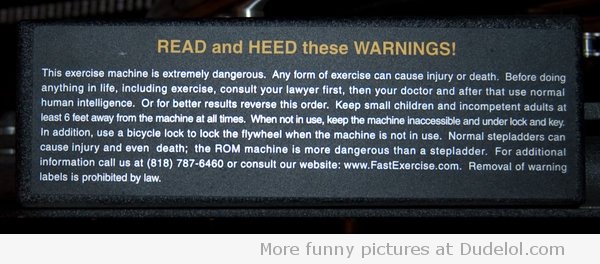haha
Give me a museum and I'll fill it. (Picasso) Give me a forum ...
To momentarily interrupt this charming new thread direction, I have a comment and a question about the supposed benefits of this machine. First, I reject the idea that very brief, very intense exercise will substitute for more prolonged workouts of moderate intensity. I don't mean that long moderate workouts are best for every purpose; Prof Tabata proved that if you can drive yourself hard enough for as little as 4 minutes 5 days/week, you get excellent anaerobic fitness and much enhanced VO2 also. Of course if you don't want to experience cardiac arrest you will need a little more time for warmup and warmdown. This sort of athletic fitness is basically impossible to achieve with only moderate exercise, even for a much longer duration.
But there are other dimensions to fitness, such as metabolic training, which I assume is most important to middle aged people who might have the money to buy one of these ROM machines. I have posted before about the research coming out of Duke, which seems to show that on the dimensions most important to health, you simply must put the time in.
My second point, which really is a question not just an opinion as was my first point, wouldn't the effort required to get the supposed benefits from this machine have to represent flat out, puke when you're done intensity? And wouldn't the average middle aged non-athlete be so turned off by the exertion required that s/he would not be able to put everything into it more than occasionally? At least for me, at this time in my life, it is easier to go out and walk 5,6,7 miles or to row on my C2 at a moderate pace for an hour or more than to contemplate running flat out for 4 minutes, or rowing flat out for 2000m. These very strenous exertions are aversive, and you do not really want to do it again the next day unless you are young and part of a team with a coach yelling at you and your teammates looking on to evaluate your performance, or in competition.
There is also the aspect of sudden death. I doubt many of us have lovely, lesion free arteries. To jump on this thing and go for broke might not be that great for our older and well used vessels
Ha
But there are other dimensions to fitness, such as metabolic training, which I assume is most important to middle aged people who might have the money to buy one of these ROM machines. I have posted before about the research coming out of Duke, which seems to show that on the dimensions most important to health, you simply must put the time in.
My second point, which really is a question not just an opinion as was my first point, wouldn't the effort required to get the supposed benefits from this machine have to represent flat out, puke when you're done intensity? And wouldn't the average middle aged non-athlete be so turned off by the exertion required that s/he would not be able to put everything into it more than occasionally? At least for me, at this time in my life, it is easier to go out and walk 5,6,7 miles or to row on my C2 at a moderate pace for an hour or more than to contemplate running flat out for 4 minutes, or rowing flat out for 2000m. These very strenous exertions are aversive, and you do not really want to do it again the next day unless you are young and part of a team with a coach yelling at you and your teammates looking on to evaluate your performance, or in competition.
There is also the aspect of sudden death. I doubt many of us have lovely, lesion free arteries. To jump on this thing and go for broke might not be that great for our older and well used vessels
Ha
Last edited:

